Which is cheaper and better - a gas tank or main gas? Comparative review
The use of gas in private households can significantly save on heating, domestic hot water and cooking. Despite all the economic crises, blue fuel remains the cheapest energy source.
But is it better to choose a gas holder or main gas for your home? Each of these gas supply methods has its own advantages and price. In order to make a choice correctly, one must take into account all the nuances of both cottage gasification schemes.
The content of the article:
What is main (natural) gas?
For people who are far from oil and gas production, an analysis of all the nuances of the “gas” issue in detail often causes a headache. There is natural, liquefied, bottled, compressed, main gas, etc. Plus, there are a bunch of abbreviations (CNG, LNG, LPG, gas turbine, APG). And all this is about the fuel that we use in everyday life for heating water (coolant) and cooking.
To understand from scratch all types of this fuel so familiar to many Russians is quite difficult.
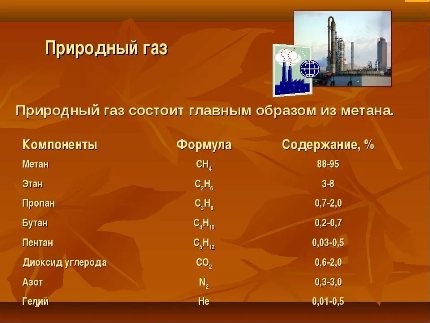
As such, natural gas extracted from the bowels of the earth is a mixture of:
- methane;
- heavy hydrocarbons (ethane, propane, butane, etc.);
- hydrogen and hydrogen sulfide;
- water vapor;
- nitrogen;
- helium and other inert gases.
Depending on the field, the proportion of the first component in this mixture reaches 70–98%.
However, the “natural gas” flowing into apartments and houses through pipes is already methane free from impurities with a tiny amount of odorant (a substance with a sharp unpleasant odor that facilitates the detection of leaks).
It is unsafe to supply the entire mixture extracted from the ground through gas pipelines for domestic use without treatment. It contains many explosive and harmful components for humans. It’s easier and safer to clean methane from everything else.
After purification at the field, this purely methane gas enters the GTS (gas transmission system).And from it through gas distribution and compressor stations it is supplied through gas pipelines, first to settlements, and then to consumers.
So, natural gas enters private houses and city apartments to be burned in gas stoves, boilers and boilers.
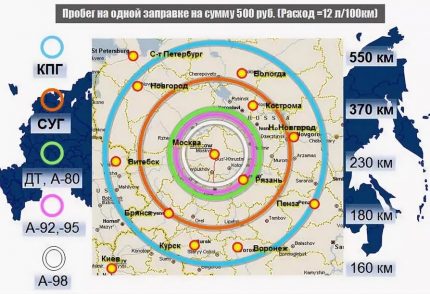
The gas in the apartment and the methane-based gas turbine are the same in composition. However, the first “flows” through the pipes in a gaseous state. But the second one is pumped into automobile cylinders in the form compressed to a pressure of 200–220 bar. Such a gas engine fuel is called compressed (CNG). It is he who is sold at Gazprom gas stations.
At the same time, there is also LPG (liquefied petroleum gas), which is also often used for filling cars. But it no longer consists of methane, but of a mixture of propane and butane. About him further - this is exactly what is pumped into gas tanks.
The methane class also includes natural gases:
- LNG (liquefied).
- APG (adsorbed).
The first to simplify transportation and storage is liquefied by cooling at minus 1600S. It is he who is carried in huge tankers across the oceans.
The second option is methane, which is adsorbed on a solid porous sorbent. Unlike LNG, equipment for maintaining ultra-low temperatures is not required for its storage.
At the same time, the pressure in the tank does not rise above 30-50 bar, so it is much easier and safer to store and transport it. However, this technology in Russia and the world has not yet received wide distribution, the high cost of adsorbent production affects.
Features of gas (liquefied) fuel
The gas holder (GasHolder) is a commonplace tank for storing gas (propane + butane). There it is pumped in a liquefied form. Then gradually this “liquid” goes into a gaseous state, raising the pressure in the tank. And already due to high pressure, gas is squeezed out of the tank into pipes for supply to the house.
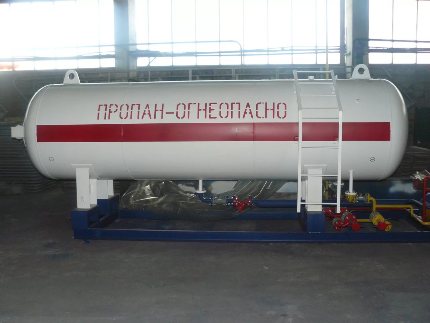
In essence, butane and propane are by-products that remain after methane is released from the “natural gas” raised from the bowels. Their share in the mixture pumped out of the ground often reaches 30%.
Plus, they are also formed during the processing of associated gas, which comes out of the wells with oil. They have to either be flared in the field, or look for ways to use them in the energy sector.
Gas holders can be used to store various gases. But for autonomous gas supply of private houses, it is customary to use equipment designed for a propane-butane mixture. It is also called liquefied petroleum gas (LPG). Engaged in liquefying methane for injection into such household containers is too expensive and disadvantageous.
The mixture of liquefied propane with butane (LPG) differs by:
- winter;
- summertime.
Butane is cheaper than propane. But it freezes faster at negative atmospheric temperatures, so it is added to the winter mixture in smaller proportions. In winter, LPG is more expensive not because of the desire of power engineers to earn more, but because of the technological need to increase the percentage of expensive propane in it.
However, it is not worth buying liquefied gas in the summer for the future. In winter, during severe frosts, the summer composition may “freeze”. It will not turn into ice, but it will become smaller in volume from a liquid to a gaseous state.

Gas holders are vertical and horizontal, and are also divided into:
- underground;
- aboveground.
In Russian climatic conditions, it is recommended to mount only the underground version. At low outside temperatures, liquefied propane-butane evaporates less efficiently.
It is easier to dig a deep pit so that the bottom of the gas tank is lower than the level of soil freezing in the area. It is more expensive to insulate and artificially maintain the temperature parameters necessary for evaporation in the tank by installing special evaporators.
Some “experts” argue that vertical gas holders, in comparison with horizontal counterparts, have lower rates of thermal return. The evaporation mirror inside them is much smaller. And indeed it is. The smaller the area of the liquid on top - the less it evaporates.
However, in vertical LPG tanks, the evaporation process proceeds at a slightly higher speed, which fully compensates for the smaller size of the "mirror". The result in the end is almost the same. It is not for nothing that in Scandinavia, where the climate is in many respects similar to the Russian one, they prefer to mount gas storage tanks in exactly vertical design.
Comparison of gas from the highway and the gas tank
Comparing both options gas supply of a private house, you need to look at the cost of buying a cubic meter of gas, as well as the estimated installation of equipment and the price of its operation in the future.
All parameters of both systems should be considered. At the same time, choosing what is initially cheaper - a gas holder and main gas, it is necessary to analyze what is easier to repair and maintain.

The gas holder is, first of all, complete autonomy in the energy supply of a private house. The main gas can be turned off at any time. It is impossible to fully insure against accidents in gas pipelines.
In this regard, blue pipe fuel is similar to electricity. The general network collapsed, and the cottage was without electricity and gas. And gas fuel is always available. It is only necessary to monitor the fullness of the tank.
Factor # 1: Connection Cost
If you look at the average prices for connecting the main gas and gas tank installation, then the first option wins greatly. Now you can connect the cottage to the gas main for 50-100 thousand rubles.
When choosing the second method, only 200 thousand rubles will have to be spent on gas-holder equipment. The larger the volume, the more expensive it is. Plus, installation and earthwork. But there are a number of nuances.
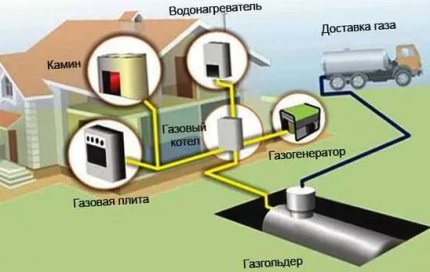
The main problem with connecting the main gas is the timing of all necessary work and approvals. If there is already a pipe in the village, then everything will happen relatively quickly and fairly inexpensively. But if from the house to the highway more than two hundred meters, then there will be a lot of trouble with the connection.
To connect the cottage to the gas pipenecessary:
- Prepare a calculation of gas consumption.
- Apply for technical conditions.
- Get these TUs (it takes up to a month).
- Prepare a draft gas network in the house and from it to the mains (another couple of weeks).
- Conclude a connection agreement with gas companies by providing them with design documentation.
- Carry out the installation of gas equipment (several days subject to the quick availability of free installers).
- Verification by the representative of the main methane supplier of the operability of the equipment and wiring both in the house and outside, with the subsequent conclusion of a service contract (the arrival of this person can be waited another month).
As a result, at least 3-4 months are obtained.And this is the case if, in the course of approvals and installation, there are no problems. Usually it takes six months price for connecting to a centralized gas supply also makes you think about its necessity.
If the village is not included in the regional gasification program, due to which many connection issues have already been resolved, then you yourself should not deal with this topic at all. There will be a lot of headache and walking around the courts.
But the process of gasification of a private house with the help of a gas tank takes only 1-3 days. Private owners do not need to go through the coordination for the installation of such a installation on their land in supervisory authorities. Decide on the cost gas tank installations Our recommended article will help.
It is only necessary to dig a pit under the tank for LPG, install it there and connect pipes to it. All the necessary sensors, control automation and valves are already included in the gas tank.
And one more nuance. Input from the highway to the house can be done on almost any site. With a gas holder, the situation is radically different. It must be removed at a certain distance from buildings, wells and roads. Not every homestead is suitable for placement of gas holding equipment, a suitable place for a container can not be found.
Factor # 2: Energy Efficiency and Service Cost
At analysis of gas fuel costs it is necessary to separate the cubic volume (displacement) of methane in the pipe and propane-butane LPG in a machine that brings liquefied fuel to the customer. If you look at the price tag in rubles / m3, it turns out that main gas costs three to four times cheaper than propane-butane.
However, in the first case, the fuel is supplied in a gaseous state, and in the second in a liquid state. As a result of evaporation, a liter of this “liquid” turns 200–250 liters of gas. Moreover, the ratio of propane and butane in the LPG gas holder still needs to be taken into account. They have different densities.
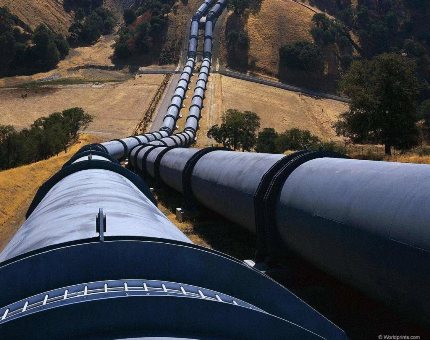
If we compare the caloric content of two types of gas fuel, then propane-butane will be ready to give odds to methane. When one cube of a propane-butane mixture is burned in a gaseous state, about 28 kW is released, while methane can produce only about 9 kW.
With an average calculation, a cottage of 100 squares for heating needs about 3000–3100 m per year3 methane or about 1000 m3 LPG. In this case, the first gas will have to pay three to four times less. As a result, it turns out that fuel costs in general for the year as a result are approximately equal.
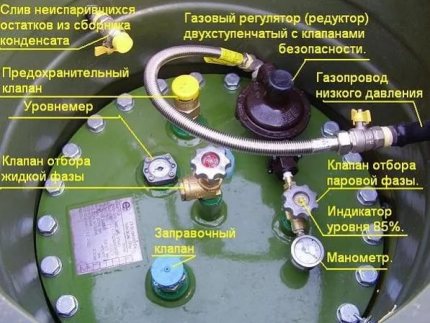
According to the Ministry of Emergencies, main natural gas belongs to the 4th, safest category of explosive gas substances. But propane-butane is included in the more dangerous 2nd group. Even with small concentrations of LPG in the room, it can explode from the slightest spark.
Moreover, methane in itself is light, in case of leaks it rises under the stream and dissipates or goes into ventilation. But the propane-butane mixture is heavy and falls to the floor or the ground, gradually accumulating there to critical values.
From the point of view of safety, main gas greatly outperforms gas. No wonder it is strictly forbidden to mount gas tanks near wells and basements, where it can leak in case of leaks from the tank.
Regulatory distances of gas tank location given here. The article recommended by us sets out in detail the rules for choosing a place to install equipment of this type.
To avoid problems with LPG, tanks for it and rooms with boilers are often equipped with special gas sensors. They instantly respond to an increase in gas concentration, warning the owner of the house about potential problems.Do not save on them.
Conclusions and useful video on the topic
The following selection of video materials will help you understand all the nuances of choosing equipment for gasification of a cottage.
Video # 1. Main gas connection step by step:
Video # 2. Advantages of autonomous gasification:
Video # 3. All the nuances of mounting a gas tank:
In all respects, the main gas for connection and consumption will cost less than LPG from the gas tank. This is especially true of the issue of initial spending. But if there is no gas line near the house, then pulling the pipe can also fly into a lot of money.
It is better to prefer the option with a gas holder: it is expensive, but it is completely autonomous and you will not need to be afraid of accidents on the gas pipeline with it.
And what do you think is better: installing a gas tank or connecting to a centralized gas supply? Please write comments in the block below. Ask questions, post a photo on the topic of the article, share useful technical nuances known only to you.

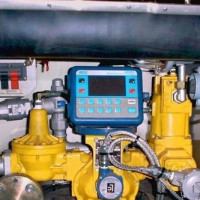 How and in what is gas flow measured: measurement methods + overview of all types of gas flow meters
How and in what is gas flow measured: measurement methods + overview of all types of gas flow meters 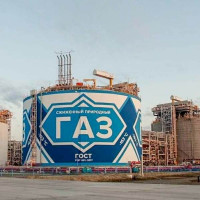 How and why liquefied gas: production technology and scope of use of liquefied gas
How and why liquefied gas: production technology and scope of use of liquefied gas 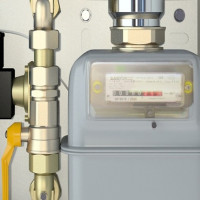 Gas consumption from the gas tank for heating: how to calculate + tips to minimize
Gas consumption from the gas tank for heating: how to calculate + tips to minimize 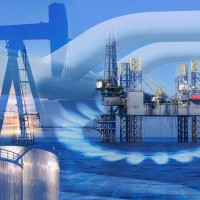 All about natural gas: composition and properties, production and use of natural gas
All about natural gas: composition and properties, production and use of natural gas 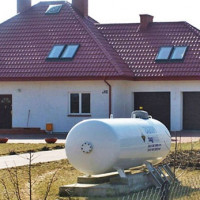 The cost of installing a gas tank in a private house: prices for gasification
The cost of installing a gas tank in a private house: prices for gasification 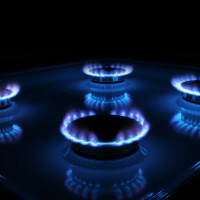 How much gas a gas stove consumes: gas flow calculation procedure
How much gas a gas stove consumes: gas flow calculation procedure  How much does it cost to connect gas to a private house: the price of organizing gas supply
How much does it cost to connect gas to a private house: the price of organizing gas supply  The best washing machines with dryer: model rating and customer tips
The best washing machines with dryer: model rating and customer tips  What is the color temperature of light and the nuances of choosing the temperature of the lamps to suit your needs
What is the color temperature of light and the nuances of choosing the temperature of the lamps to suit your needs  Replacement of a geyser in an apartment: replacement paperwork + basic norms and requirements
Replacement of a geyser in an apartment: replacement paperwork + basic norms and requirements
After the construction of the country house, the question arose of connecting the gas system. Initially, I planned to connect the main gas: it is much cheaper and easier. But then, after analyzing all the pros and cons, he stopped at the installation of the gas tank. There may be failures in the supply of the trunk option, and with the gas holder you yourself control the process. A gas holder is expensive both in maintenance and installation, but it outperforms the main line.
If the gas is normal, then it will not freeze.
We heat 130 m2 at home with the help of a gas tank of 1450 liters. There was enough gas for less than 2.5 months, starting in October, when there was no frost at all. Maybe a cheating service company or not the competence of workers during installation? But the price for a month of heating came out to about 15,000 rubles.
I agree with Igor. Gas from a gas holder is very expensive. The house of 260m2 of 3000 liters was enough for 2 months. 2000 liters per 1.5.
Those. in fact comes out approx. 26 000 thousand. I do not know what it is, a deception of the company or the incompetence of workers during installation. My gas tank is considered as an intermediate option. For all the high cost of connecting the main gas, I am currently doing just that.
I wonder if it will be much more expensive to be heated by electricity? Because the costs are just terrible.